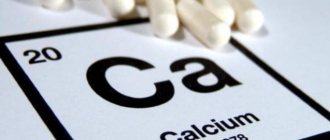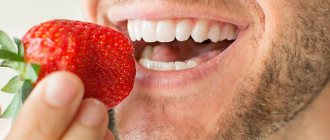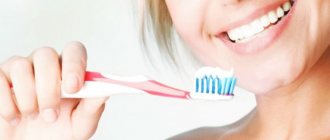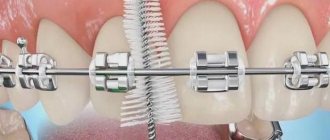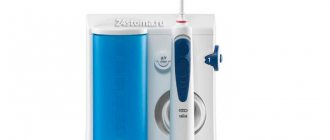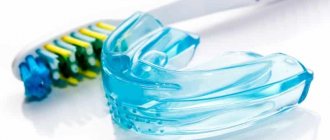Coffee is one of the favorite drinks of many, which, in addition to its wonderful taste and invigorating sensations, also carries not only a positive, but also a negative effect on our teeth, which consists in changing the color of the enamel and acquiring a yellow or dark tint. This happens because the enamel structure is porous, and coffee beans contain coloring substances. They penetrate into the pores and microcracks of the enamel, as a result, the teeth acquire an unattractive appearance. Get more professional information about the effect of coffee on teeth in Saransk We offer at the dental clinic “STOMATOLOGIYA”, which is located at: st. Ulyanova, 93, room 3.
How does coffee affect tooth enamel?
In order to understand how coffee affects teeth, you need to compare the factors of the positive and negative effects of this drink, and then draw conclusions for yourself.
Positive effects of coffee:
- the presence of antioxidants helps prevent the development of inflammatory processes in the oral cavity;
- it does not contain aggressive acids, unlike carbonated drinks that destroy tooth enamel;
- drinking 1-2 cups a day helps reduce the development of dental bone tissue atrophy;
- the bactericidal properties of the drink, the presence of catechins and their derivatives in it does not allow bacteria to linger on the enamel, which prevents the development of caries;
- It is believed that the chemical composition of caffeine helps prevent the development of malignant tumors of the mouth and throat.
All of the above applies only to natural coffee drinks, which do not contain cream, sugar, etc.; the effect of these components on tooth enamel is considered separately.
Among the negative factors, the following are noted:
- staining of the enamel, this occurs due to the presence of microcracks in it, in which coffee remains; if the teeth are healthy, then there is nothing to be afraid of;
- adding sugar to a drink negatively affects the condition of your teeth, try drinking unsweetened coffee, this will reveal its taste much better;
- Drinking a hot drink outside in cold weather leads to the appearance of microcracks in the enamel, which arise due to a large temperature difference.
Based on the described qualities of coffee, it is clear that its moderate and correct intake does not lead to the formation of coffee plaque and does not harm the enamel. A natural and unsweetened drink, consumed in moderation, is not hazardous to health. The danger is sugar, which, remaining on the enamel, is a breeding ground for bacteria, which leads to the development of caries.
It is not recommended to drink any hot liquids in the cold, wash them down with cold water or eat ice cream.
If you drink more than 4 cups of this drink a day, then in addition to yellowed enamel, other problems may appear:
- weight gain, because metabolism slows down;
- overload of the nervous system;
- weakened immunity;
- malfunctions of the thyroid gland.
Scientists conducted an experiment in which completely healthy teeth were placed in different liquids for 10 days. After this, the condition of the enamel of each specimen was examined under a microscope. The one that was in coffee changed the least: the pigmentation of the enamel practically did not change, there was no disorientation of the dentinal tubules, and their narrowing occurred in isolated cases. The experiment was carried out in laboratory conditions, and people often have microcracks in their enamel, caries, etc., so the results will be different.
Can tint appear due to coffee with milk?
Some people add milk to the smoothie and believe that this way they reduce the effect of coffee on tooth enamel. There is a grain of truth in this.
Scientists conducted an experiment. They placed the extracted teeth in two containers. One had black espresso, the other coffee with milk. In black coffee, the tooth darkened, but in a drink without milk, the color did not change. This means that milk neutralizes the harmful effects of the dye.
But the ratio of components also affects. Too strong coffee with milk in small quantities harms your teeth more than a weak drink without milk.
Another reason to add milk is calcium, which is necessary for the strength of the tooth surface. The lack of substance also affects the appearance of the shade. Therefore, it is better for coffee lovers to choose between latte and cappuccino, and not overuse espresso.
Why do teeth turn yellow and plaque appears?
Coffee beans contain natural coloring. Thus, drinking a lot of coffee and the presence of microcracks on the teeth explain why coffee turns teeth yellow. After any meal, plaque remains on the enamel, and if it is not removed in time, it accumulates, like a sponge absorbs dyes and darkens. Stains appear not only from coffee; tea, juices, red wine, and colored soda have this effect.
If the enamel is healthy and its surface is constantly cleaned from plaque, then dark or yellow spots will not appear. The harm from natural coffee is much less than from freeze-dried coffee. If the tooth enamel has darkened, you should not start this process, but urgently contact a dentist who will help you cope with the problem.
The amount of organic acids in different types of coffee varies. It is believed that there are more of them in Robusta than in Mocha and Arabica, so for those who prefer the first option, the enamel turns yellow faster. It is recommended to drink no more than 2 cups of coffee per day, after which you should immediately clean your mouth. In this case, there will be no negative consequences in the form of yellowness.
Some people naturally have a yellowish enamel color, and drinking coffee and smoking cigarettes makes this feature even more prominent.
How to get rid of yellow plaque from coffee in Saransk
Yellow plaque and darkening of the enamel from excessive consumption of coffee drink can be easily eliminated by brushing your teeth and, for more serious cases, by whitening. It is recommended to consult a dentist for detailed advice and a solution to this problem, taking into account your specific case.
You can find out more information on teeth cleaning or whitening in Saransk from the clinic administrator by calling: +7 (8342) 308–088, +7 (8342) 777–507 or by filling out the electronic registration form.
Ways to whiten teeth from coffee stains
Depending on the condition of the teeth, you can fight their yellowness with folk remedies, with the help of medications, or you will have to turn to professionals.
Folk remedies
There are several proven folk methods that help eliminate slight yellowness of tooth enamel:
- baking soda, gently rub it in with a cotton swab or toothbrush, then rinse the mouth;
- activated carbon, it is ground into powder and then used as toothpaste;
- hydrogen peroxide, rinse your mouth with its solution, do this for no more than 2 weeks, otherwise the enamel will begin to partially dissolve;
- strawberries, apples, lemon peels, they are used to wipe tooth enamel, do this no more than 1-2 times every 2 weeks, so that the acid in these products does not lead to thinning of the enamel;
- turmeric powder, from which a paste is made with water;
- banana skin, teeth rub it on the inside.
Professional whitening
If the condition of your teeth is poor, you will not be able to cope with the problem on your own, so in such cases you should contact a dentist as soon as possible. In a modern clinic, cleaning is carried out in the following ways:
- Polishing using abrasives (soda, lemon powder). In this way, soft plaque is removed.
- Ultrasound treatment. Helps fight dense fossilized deposits.
- Using a laser. This is the most effective method, the disadvantage is that it is expensive, there are many contraindications, so it is not suitable for everyone.
- Dry cleaning. To do this, use a concentrated solution of hydrogen peroxide.
If a person has thin enamel, then the described methods of whitening it will have to be abandoned.
other methods
In addition to the described options that help make your smile dazzlingly white, there are several more ways to deal with yellowed enamel:
- hard toothbrushes in combination with whitening toothpastes;
- use of a modern ultrasonic brush;
- whitening strips, they are glued to the enamel, left for 30 minutes and removed, the result is visible after 2 weeks;
- special gels, they are applied daily for 2 weeks to the cleaned surface of the teeth;
- whitening trays help fight old yellow discoloration, use them in accordance with the available instructions;
- sticks and chewing gum, they are used after drinking coffee, when there is no way to better clean the oral cavity.
Consultation with a hygienist
Before this appeal, the young man had never been to a hygienist, but he had heard from friends that with the help of professional teeth cleaning you can remove the most stubborn stains without damaging the enamel. The hygienist conducted an examination and found out that the young man does not smoke, but drinks a lot of coffee. Dark spots on teeth are pigmented plaque. Pigments from coffee and strong tea stain hard plaque on teeth, and these stains are very difficult to clean with home remedies.
Tartar has formed on the inner surface of the teeth, which presses the gums away from the teeth, opening the path for infection to the roots of the teeth, disrupting blood circulation in the gums. Tartar is the cause of bad breath.
The hygienist applied a plaque indicator to the patient's teeth to determine the effectiveness of self-hygiene.
Purple staining along the gums indicates that these areas need to be cleaned more thoroughly. The front teeth are slightly larger than the adjacent ones, so the young man does not grab the tops of the teeth when brushing. You need to pay more attention to these places, making sweeping movements with the brush when cleaning, from the gums to the edges of the teeth, grabbing the surface of the gums too.
Determining the acidity of saliva helps identify the risk of developing caries and the need for more frequent visits to the dentist for examination. In this case, the acidity of saliva is slightly alkaline, there is no increased risk of caries.
How to avoid plaque?
If you are a big fan of this drink, but want to ensure that coffee stains never appear on your teeth, you should adhere to the following recommendations:
- due to the fact that the enamel turns yellow due to the presence of microcracks in it, it is necessary to monitor the condition of the teeth;
- drink the drink through a straw, this solution helps reduce the contact of the enamel with the liquid consumed;
- Low caffeine coffee contains less coloring matter;
- after each coffee procedure, you should rinse your mouth with warm water;
- drink quickly so that the drink does not linger long in the mouth;
- coffee brewed in a Turk will contain more polyphenols than coffee brewed in an espresso machine;
- To prevent your teeth from turning yellow, after each meal you need to brush not only them, but also your tongue, otherwise the bacteria on it will negatively affect the condition of the enamel.
What is more harmful: coffee or tea?
There is an opinion that tea is less harmful than a coffee cocktail. In fact, both drinks contain about the same amount of caffeine. This is discussed in detail in the article “Where is there actually more caffeine: in coffee or tea? Let's count."
From this we can conclude that the coloring effect of coffee and tea will be the same. The latter will also intensify if, after drinking, you rinse your mouth with preparations containing chlorhexidine.
Drinking coffee after a dentist appointment
Many people have a hard time with any visit to the dentist and, in order to relieve nervous tension, try to drink coffee immediately afterward. There are a number of restrictions when doing this is not recommended.
Removal of a tooth
After surgery involving tooth extraction, there is always an open wound. In order not to provoke bleeding and other complications, you must refuse any food or drink for 2-3 hours.
A hot drink will dissolve the blood clot; in addition, caffeine dilates peripheral vessels, increases blood pressure, and therefore there is a risk of bleeding.
Implantation
Another surgical operation performed in the oral cavity is the installation of dentures. In this case, tissues are also damaged, and drinking hot drinks will lead to the consequences already described. It is recommended to drink them no earlier than 5 days after implantation.
Teeth whitening
After the whitening procedure for 2 days, you need to be especially careful. You should not take products that have a coloring effect. Over the next 2 weeks, you need to drink a minimum amount of your favorite drink, after which you can return to your usual diet.
Ultrasound teeth cleaning
In this, as in the previous case, after the procedure you must give up coffee for 2 weeks. If this is difficult, then at least drink it in minimal quantities, without sugar and dilute it with milk.
Installation of a seal
The peculiarity of any fresh filling material is that it absorbs any dyes well. To preserve the original color of the filling, it is better to avoid drinking drinks containing caffeine for 2-3 days after its installation.
Can coffee cause toothache?
Coffee by itself cannot cause toothache. Problems arise when a person has sensitive enamel and drinks a very hot or sweet drink.
Thus, information about the dangers of coffee for health and the color of tooth enamel is a little exaggerated. To ensure that coffee ceremony lovers do not have negative consequences after it, it is necessary:
- adhere to the rules of admission;
- maintain oral and dental hygiene;
- carry out preventive measures.
If everything is done correctly, then there will be no more harm from drinking this drink than from any other.
